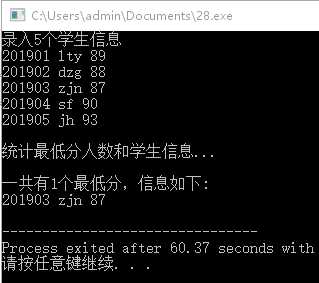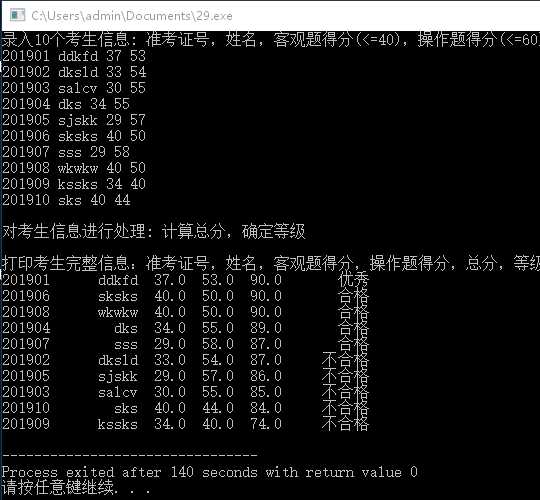实验六
Posted txaalo
tags:
篇首语:本文由小常识网(cha138.com)小编为大家整理,主要介绍了实验六相关的知识,希望对你有一定的参考价值。
Part 1
ex1-2
在结构体数组stu中查找最低分,查找成绩与最低分相同的学生,将其信息保存在数组t中,返回最低分学生个数。
#include <stdio.h> const int N=5; // 定义结构体类型struct student,并定义STU为其别名 typedef struct student long no; char name[20]; int score; STU; // 函数声明 void input(STU s[], int n); int findMinlist(STU s[], STU t[], int n); void output(STU s[], int n); int main() STU stu[N], minlist[N]; int count; printf("录入%d个学生信息\\n", N); input(stu, N); printf("\\n统计最低分人数和学生信息...\\n"); count = findMinlist(stu, minlist, N); printf("\\n一共有%d个最低分,信息如下:\\n", count); output(minlist, count); return 0; // 输入n个学生信息,存放在结构体数组s中 void input(STU s[], int n) int i; for(i=0; i<n; i++) scanf("%ld %s %d", &s[i].no, s[i].name, &s[i].score); // 输出结构体s中n个元素信息 void output(STU s[], int n) int i; for(i=0; i<n; i++) printf("%ld %s %d\\n", s[i].no, s[i].name, s[i].score); // 在结构体数组s中,查找最低分学生的记录,将其存入结构体数组s中 // 形参n是结构体数组s中元素个数 // 函数返回最低分的学生人数 int findMinlist(STU s[], STU t[], int n) // 补足函数实现 // ××× int i,j=0; int min; min=s[0].score; for(i=0;i<n;i++) if(s[i].score<min) min=s[i].score; for(i=0;i<n;i++) if(min==s[i].score) t[j++]=s[i]; return j;
运行结果如下:

ex1-3
#include <stdio.h> #include <string.h> const int N = 10; typedef struct student long int id; char name[20]; float objective; float subjective; float sum; char level[10]; STU; void input(STU s[], int n); void output(STU s[], int n); void process(STU s[], int n); int main() STU stu[N]; printf("录入%d个考生信息: 准考证号,姓名,客观题得分(<=40),操作题得分(<=60)\\n", N); input(stu, N); printf("\\n对考生信息进行处理: 计算总分,确定等级\\n"); process(stu, N); printf("\\n打印考生完整信息:准考证号,姓名,客观题得分,操作题得分,总分,等级\\n"); output(stu, N); return 0; void input(STU s[], int n) int i; for(i=0;i<n;i++) scanf("%d %s %f %f",&s[i].id,&s[i].name,&s[i].objective,&s[i].subjective); void output(STU s[], int n) int i; for(i=0;i<n;i++) printf("%5d %10s %5.1f %5.1f %5.1f %10s\\n",s[i].id,s[i].name,s[i].objective,s[i].subjective,s[i].sum,s[i].level); void process(STU s[], int n) int i,j,k,m=0; STU temp; for(i=0;i<n;i++) s[i].sum=s[i].objective+s[i].subjective; for(j=0;j<n;j++) for(k=j;k<n;k++) if(s[j].sum<s[k].sum) temp=s[j]; s[j]=s[k]; s[k]=temp; while(m<=n) if(m<=n*0.1-1) strcpy(s[m].level,"优秀"); else if(m>n*0.1-1&&m<=n*0.5-1) strcpy(s[m].level,"合格"); else strcpy(s[m].level,"不合格"); m++; ;

Part2:共用体类型及编程示例
共用体与结构体类型的区别?
1.共用体类型在于变量共占一段内存,然而结构体类型在于每个变量占有不同的内存空间;
2.结构体占用的内存为各变量各自所占内存之和,而共用体类型则是其中一个变量所占最大内存。
Part3:枚举类型及编程示例
枚举类型用于描述哪一类数据?
枚举类型用于描述整型常量,且不能直接输出;int类型数值赋值给枚举类型变量,必须强制类型转换,反过来可以直接赋值。
以上。
以上是关于实验六的主要内容,如果未能解决你的问题,请参考以下文章